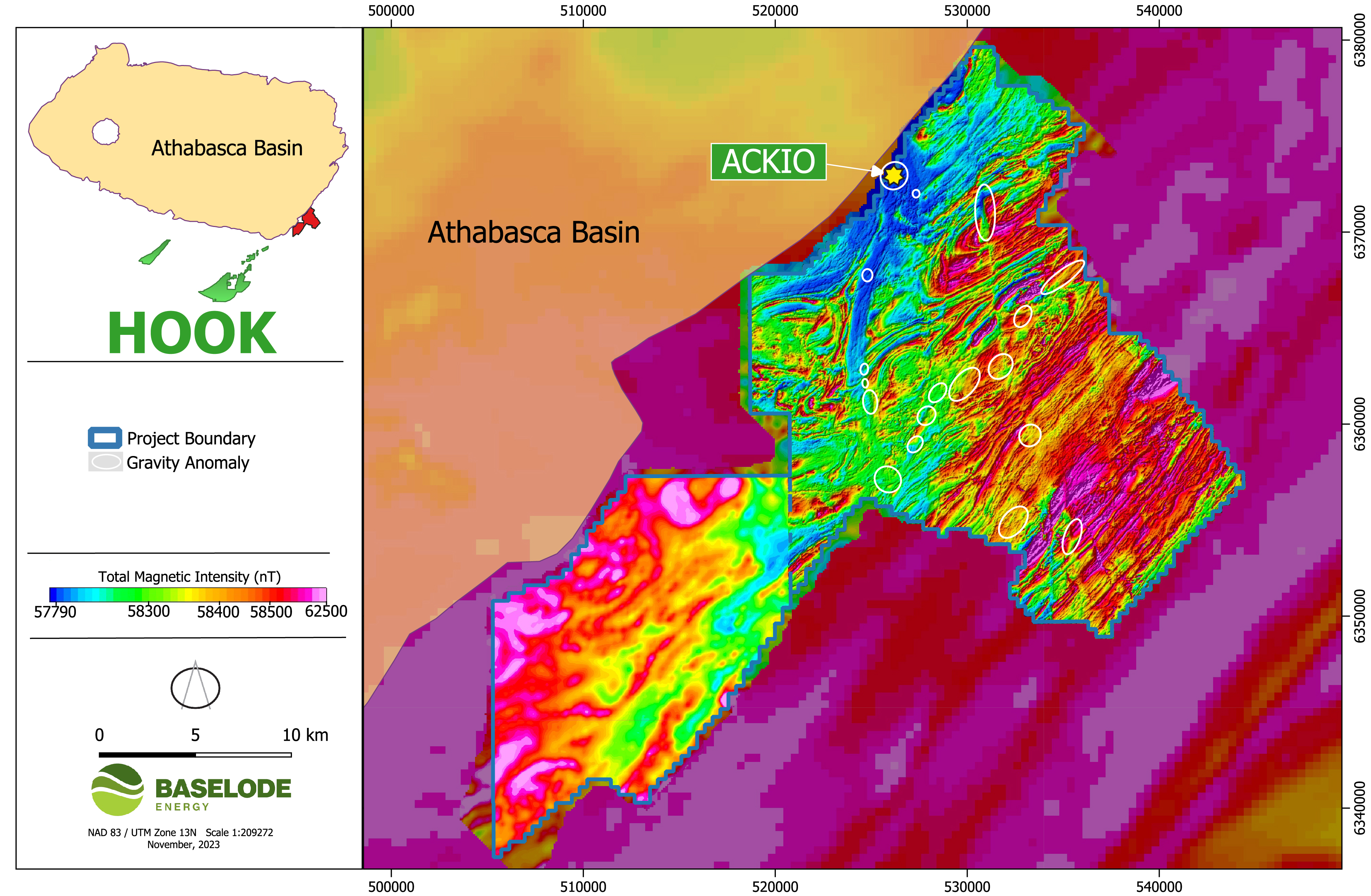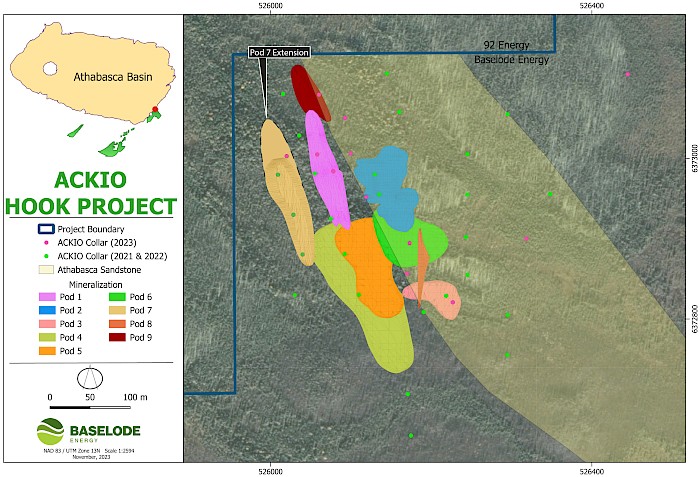Hook - ACKIO
About the Hook Project
The Hook Project is 100% owned by Baselode Energy with no underlying royalties or option agreements. Hook is on a northwest-oriented geophysical strike with two high-grade uranium occurrences; the McArthur River mine and the Hook Lake surface showings where veins have returned 44.5 wt% U3O8 from grab samples.
Hook Project - ACKIO Uranium Discovery
Mineralization starts as shallow as 25 m beneath the surface and down to approximately 300 m depth with the bulk of mineralization occurring in the upper 190 m. ACKIO measures greater than 375 m along strike, greater than 150 m wide, comprised of at least 5 separate zones, and remains open to the west, south, and along the Athabasca sandstone unconformity to the north, east and south.
Drill Results, ACKIO & Exploration - 2022
In 2022, a 22,500-metre drill program was completed on the ACKIO high-grade uranium discovery, located in the Athabasca Basin.
Drill Highlights included.
- AK22-009: 0.28% U3O8 over 10.5 m at 107.6 m true vertical depth includes 0.51% U3O8 over 2.0 m
- AK22-011: 0.69% U3O8 over 3.6 m at 144.6 m true vertical depth includes 1.26%
- AK22-032: 0.55% U3O8 over 13.2 m at 136.0 m true vertical depth includes 0.99% U3O8 over 6.3 m
- AK22-047: 1.67% U3O8 over 7.5 m at 99.3 m true vertical depth includes 2.45% U3O8 over 5.0 m
- AK22-068: 0.50% U3O8 over 18.5 m starting at 55.2 m true vertical depth which includes 1.53% U3O8 over 3.5 m
- AK22-069 of 0.90% U3O8 over 31.0 m starting at 69.3 m true vertical depth which includes 1.86% U3O8 over 12.5 m at 79.7 m true vertical depth.
A webinar from James Sykes, CEO of Baselode and Cameron McKay, VP of Exploration detailing interpretations and understandings of assay results from ACKIO can be found here.
Drill Results, ACKIO & Exploration - 2023
Baselode completed 36 drill holes for 7,512 (AK23-081 to AK23-116). ACKIO consisted of 30 drill holes for 6,193 m, Mirror consisted of 5 drill holes for 1,145 m, and 1 drill hole for 174 m was completed on a regional exploration target.
ACKIO expansion & exploration milestones achieved;
- Discovered a new zone of near-surface mineralization at Pod 7 with mineralization starting at 32 m from surface
- Pod 7 has grown in thickness, depth, and strike length, and with higher-grade potential now being recognized
- Intersected best results at depth; mineralization, alteration and structure remain open and strong at depth
- Multiple drill holes with greater than 30 m of mineralization demonstrates a system endowed with multiple thick sequences of uranium mineralization
Drill hole highlights include;
- AK23-095 0.41% U3O8 over 34.85 m at 46.65 m (43.5 m true vertical depth) includes 1.11% U3O8 over 7.4 m at 70.6 m (Pod 1)
- AK23-096 0.36% U3O8 over 20.0 m at 54.0 m (49.7 m true vertical depth) includes 0.70% U3O8 over 4.0 m at 58.5 m (Pod 1)
- AK23-088 0.32% U3O8 over 16.5 m at 184.0 m (166.8 m true vertical depth) includes 0.69% U3O8 over 1.55 m at 185.45 m and 0.75% U3O8 over 1.5 m at 193.5 m (Pod 4)
Drill Plans - 2024
Baselode is planning to complete a helicopter-supported drill program scheduled for late Q2 2024. The program is planned for 10,000 metres of delineation & expansion of the ACKIO uranium system. A separate exploration drill program is planned for 2,000 m in 8 to 10 drill holes in 4 to 8 areas targeting a number of gravity-low target areas.
Location and Infrastructure
Hook is located 40 km southeast from the McArthur River mine, 60 km northeast from the Key Lake uranium mill, and 16 km west of all-season Provincial highway 905 and powerlines. The Property encompasses ~62,000 hectares adjacent to the Athabasca Basin.
ACKIO is 30 km southeast of well-established infrastructure, including an all-season road and powerline between Cameco Corp.’s (TSX: CCO) and Orano’s McArthur River mine and Key Lake uranium mill joint ventures. ACKIO is 70 km northeast of the Key Lake mill.
Property Geology
The Hook project is hosted within the basement rocks of the Wollaston domain, which hosts the highest grade uranium deposits in the world. This is in line with Baselode’s “Athabasca 2.0” strategy: exploring and developing projects with little to no sandstone cover, in areas that have deep rooted structures with ideal structural “traps” for uranium mineralization.





